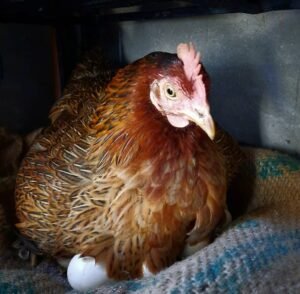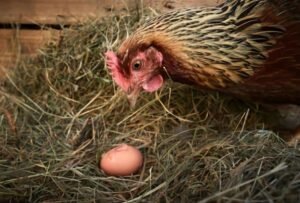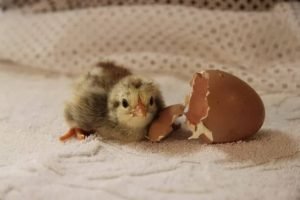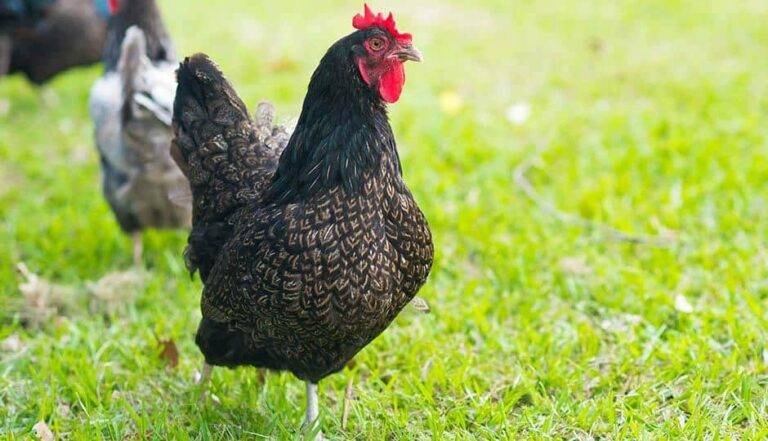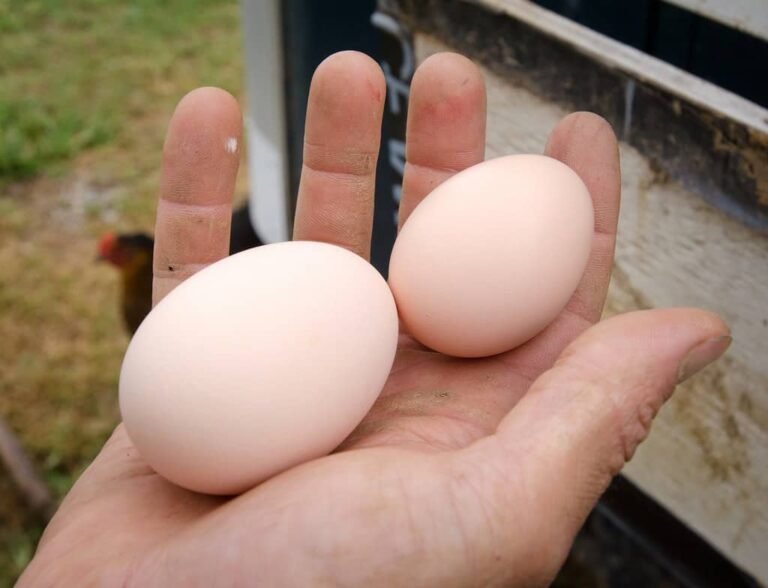Faverolles Chicken – Characteristics, Origin, Breed Info and Lifespan

Have you seen a chicken with a beard before? Well, you’re about to see one. Here’s a guide about this awesome heavyweight beardy chicken: the Faverolles.
In this piece, you will get to find out all you need to know about this unique chicken.
You will learn about its egg-laying ability, origin, and what the Faverolles are best used for.
Also, you will find out why this chicken may not fit into your farm.
Let’s get started!!!
What is a Faverolles chicken?
The Faverolles are weighty bearded and leg-feathered chickens from France.
Usually, it’s reared for meat and egg production.
In addition, they are comic birds that have the ability to make you smile.
That’s a very rare ability for chickens.
Their graceful, docile, and regal nature makes the Faverolles roosters the king of the flocks.
But here’s the disclaimer, they’re loud birds!!!
Helpful Article:
How to Start Poultry Farming for Beginners [The Complete Business Guide]
What is the origin and history of Faverolles chickens?
Faverolles are chicken breeds developed in North Central France in the 1860s.
History has it that it originated from the Houdan and Faverolles villages.
Hence, the name, Faverolles.
Originally, it was bred as a dual-purpose utility fowl in France.
It is a good source of meat and eggs.
In 1886, these breeds of chickens were exported to the UK.
That’s because a need arose for it to become a show bird.
In the same year, the breed was altered to meet exhibition standards.
Furthermore, British breeders developed a type of Faverolles that has longer and perky tail feathers than their German and French Cousins.
Following this, the Salmon breed was birthed. This was in response to the need for more fleshy egg-laying chickens for sale.
Also, the French farmers need a hen that bears confinement more than the Houdan chickens.
The Salmon Faverolles’ genetic traits were said to have traces of Houdan, Brahma, French Rennes, Flemish cuckoo, Malines, and Dorking mixes.
In the early 1900s, the Faverolles chickens made it to the USA via an importation made by Dr. Phelps of Glen Falls, New York.
Today, the famous French pride chickens are now primarily raised for exhibitions.

What are the characteristics of Faverolles chickens?
Each chicken breed has what they’re known for.
As a result, spotting a Faverolles chicken will not be pretty difficult.
This is so because when compared to other chicken breeds, it’s unique.
Below are the characteristics of the Faverolles chickens;
1. Faverolles have beards:
Weird, right?
Well, they do. These sets of chicken breeds have adorable-looking beards on their fluffy faces.
You don’t get to see that on other chicken breeds.
2. This set of chicken breeds have feathered feet:
Peculiar to the Faverolles as well as some other chicken breeds is the presence of furry feathery legs.
These feathery legs, though beautiful, can breed a lot of dirt.
Each foot of the Faverolles has five toes rather than the usual four.
3. Faverolles chickens are all-round chickens:
Although primarily kept today as an ornamental and exhibition breed, it remains an excellent layer, as well as a fine meat chicken.
In other words, you can keep them for eggs, and meat or sign them up for shows.
4. The Faverolles come in varieties of colors:
Usually, the salmon hens are brown and creamy white. Whereas the roosters are darker, with black, brown, and straw-colored feathers.
Other varieties can be white, black, ermine, cuckoo, splash, and blue in color.
5. These birds are extremely docile:
Almost any chicken can bully the Faverolles. They are too calm.
The roosters are the quietest of all the breeds.
The only advantage of this attribute is that they are calm which makes them ideal for suburban areas.
6. Usually, they weigh between 3.17kg and 4.98kg:
On a general note, these sets of chickens are heavy birds.
According to the Poultry Club of Great Britain, Faverolles roosters weigh 4.08–4.98 kg while young roosters weigh 3.4–4.53kg.
The hens on the other hand weigh between 3.4–4.3 kg and the pullets 3.17–4.08 kg.
Their heavy fleshy nature makes them an excellent source of meat.
7. They possess an almost nonexistent wattle with a single comb:
Faverolles chicken breeds are single-combed buddies. Their comb is red in color and it has 5 points.
On the other hand, their wattles are almost nonexistent. Like they’re really small.
8. The Faverolles have a trapezoidal body shape with multi colors:
This heavyweight champion of a bird has a deep, broad body. The deepness extends through the keel.
Its back and breast are full and comprehensive.
Talking about this colorful bird, its beak is slightly different.
It has a pinkish/horn-colored beak.
Their eyes are a reddish bay.
The Faverolles’ feathers are rich, honeyed salmon-colored over the back, head, and wings.
Also, their feathers are fluffy and loose. This makes them look bigger than they actually are.
Their breast is white/straw-colored and speckled with salmon.
But the breast, muff, and lower half of the body possess a lighter straw/cream color.
Their legs are white as their skin and under their fluff is grey in color.
9. The Roosters and hens do not have the same color:
This is another defining characteristic of the Faverolles.
While the roosters have black beards, undercarriage, and breasts, the hens look totally different.
10. The Faverolles roosters are Non-aggressive:
The roosters of this breed have a long-standing reputation for being calm.
They’re totally non-aggressive. Rather they behave like the king of the flocks.
11. These birds grow fast but mature late:
What a paradox!
The Faverolles tend to outgrow the chick stage very early.
But usually, they take longer to reach a size where they can be considered good for meat.
Also, they start laying eggs on time.
12. They’re healthy birds:
Aside from the lice infestation, the birds are healthy.
All you need to do is check them regularly to avoid infestation.
Table summarizing the Faverolles breed information
| Skin color | White |
| Egg color | Light brown to pinkish |
| Comb type | Single |
| Setter/Broody | Yes |
| Especially Docile | Yes |
| Use | For Meat and eggs |
| Cold Hardiness | Hardy in winter |
| Conservation status | Threatened |
| Heat Tolerance | Tolerates heat very well |
| Also Known As | |
| Personality | Exuberant, friendly, curious, and comical |
| Country of origin | France |
| Standard | American and France standards |
| Bears Confinement | Bears confinement well |
| Weight | Roosters: 4.08–4.98 kg Young roosters: 3.4–4.53kg Hens: 3.4–4.3 kg Pullets 3.17–4.08 kg |
| Varieties | SalmonWhite |
Why choose Faverolles chickens?
What makes these chickens so unique?
If you’re looking for reasons why this breed of chicken will be a good option for you, see the reasons below;
1. Faverolles chickens are excellent for children:
If you want a chicken breed that wouldn’t scare the heck out of your children, then the Faverolles will be it.
Actually, most kids use them for their 4H projects.
Also, they make great pets.
2. Faverolles chickens are docile:
These chickens tend to be very friendly, placid, and gentle.
When taken good care of, they become affectionate towards their minders.
3. They are consistent egg layers:
Even though they do not lay many eggs like the Isa Brown chickens, they lay quite enough consistently.
These chickens are faithful egg layers even in winter.
Therefore, you can trust them to give you eggs throughout the year.
4. They are quite broody:
The Faverolles hens are broody chickens. They can even brood on an empty nest thinking there are eggs.
Also, they make amazing mothers when they hatch.

What are the disadvantages of having the Faverolles Chickens?
These sets of chicken breeds can be a valuable addition to the flock.
However, to tend these chickens, you must be aware of the features that may not sound good.
Below, you may find reasons to gird up your loins for the inevitable or quit the decision to get Faverolles.
1. These sets of beauties are overly prone to lice and mites infestation:
With furry feathers come mice and lice. And this can be really discomforting for these french beauties.
Also, their feathered legs are also prone to scaly leg mites.
And the leg feathers usually make it unnoticeable.
A regular routine checkup should keep this in check.
2. Faverolles are susceptible to dust:
What this means is that you get to clean and dust these birds regularly.
And that sounds like a lot of work!!!
When dusting them, be careful of their eye region and beak.
The dust can irritate them.
3. Although they grow faster than other chicken breeds, they take time to reach table weight:
Faverolles may take time before maturing for meat.
As a heritage breed, the Faverolles actually take 6-8 months to reach a decent body size.
So, if you’re expecting a full heavy Faverolles in a few months, that will be disappointing.
4. Faverolles chickens need extra help to prevent frostbite:
The Faverolles roosters are susceptible to frostbite.
But with a jar of Vaseline by the side that wouldn’t be much of a problem.
Also, in winter they will require a dry coop and run at all times.
5. These robust buddies are noisy:
Faverolles chicken breeds are loud birds.
Now, this loudness doesn’t come sometimes.
They are always loud.
If you’ve never met an expressive vocal chatty chicken, then you need to meet the Faverolles.
If you have neighbors, you may want to think twice about getting this chicken breed.
In other words, they are not ideal for urban and suburban regions.
6. These buddies may need to visit the barber’s shop:
Just like the Polish chickens, the Faverolles may require you to trim its muffs, beards, and the 5th toe.
This will give them a better quality of life.
And that might be quite a task.
Frequently Asked Questions About Faverolles chickens
1. What is the lifespan of Faverolles chickens?
These robust heavyweight birds can be expected to live between 5-7 years.
Of course, this is dependent on how well taken care of they are.
2. Are Faverolles chickens good for meat?
Yes. The Faverolles are good meat producers.
When they reach table weight, they make very tasty meat.
If you are looking to put food on the table, the Faverolles dress out at a decent weight for a small family.
3. Can Faverolles chickens be trained as pets?
Yes, they can.
Both the roosters and hens make great pets.
And for the records, they are the most popular chicken breed to keep as pets.
They are comical, gentle, mellow, and non-aggressive.
And usually, they do well with kids.
If you want a hen that makes you smile, one you cuddle, then the Salmon Faverolles may be for you!
It will only take a matter of time for these friendly french ladies to find a spot in your heart.
4. Are Faverolles chickens good egg layers?
Well, these all-around chickens are good egg layers.
Although they are primarily kept for show and ornamental purposes, these birds can still lay a considerable number of eggs.
5. How often do Faverolles chickens lay eggs?
On average, the Faverolles hen will lay about four eggs in a week.
This brings the count to about 240 eggs in a year.
Basically, these chickens just lay enough for the family.
And once they start laying, they will lay well through the winter.
But if you want a chicken that will give you more, go for the Australorps.
6. What do Faverolles chickens eat to grow big?
A decent feed is enough to keep these chicken breeds going.
You do not need to feed them anything spectacular for them to get big.
Naturally, they are heavy and fleshy chickens.
7. How fast do Faverolles chickens grow?
As earlier stated, the Faverolles are fast-maturing birds. They tend to mature earlier than other chicken breeds.
Once they get to puberty, which takes about 20 weeks, they start to lay.
8. Are Faverolles chickens noisy?
Absolutely.
And this is not good for urban and suburban dwellers.
9. What are the habitat and environment of Faverolles chickens?
These chickens can adapt both in confinement and free range.
Since they are poor flyers, they really do not require high fences to keep them in.
If you want to practice the free-range system, they are usually happy in a smaller yard. But if you can afford more space, that’s best.
Conclusion
These very docile chickens are considered to serve as good table food.
But just like the Rhode Island Red, their loud noise makes them a scare for farmers living in urban and suburban regions.
We hope the information on this page gives you all you need to know to add or quit the decision to add the Faverolles to your farm.
References
- 12 Best Chicken breeds for Eggs – chicken breeds for eggs
- When Do Chickens Start Laying Eggs Regularly?
- How Many Eggs Does A Chicken Lay In A Week?
- Fermenting chicken feed – The definitive guide
- 10 Sure Ways To Stop Chickens from Eating Their Eggs [+Bonus]
- 6 Best Chicken Egg Incubators for Chicken Eggs and Other Birds
